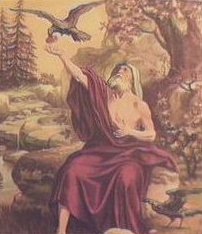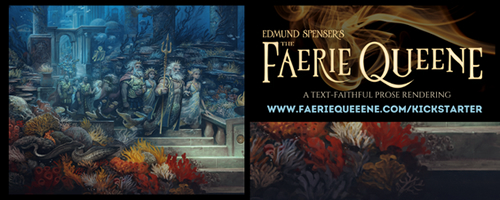Part Three: How To Bring Myths & Fairy Tales Back From The Dead & Into The Light
 Do not throw stones at ravens.
Do not throw stones at ravens.
I said last week: “Ravens? What have ravens to do with anything?”
Well, in myths and fairy tales—and symbolically—quite a bit.
Odin had two, Hunnin and Munnin, thought and memory by meaning, and they roamed the world and brought the god news. In Celtic myth, they are associated with death and war and prophesy. In Greek myth, the raven started out white, but Apollo turned it black for bearing bad news. A variant of the King Arthur stories claims the king did not die, but rather turned into a raven. The raven (and its cousin the crow) figure in various Aesop’s fables, including one where the raven is said to feed on the food offerings on altars and longs to be white and lovely as a swan. (I can see a story with racial issues right there.) The Brothers Grimm give us two famous tales, both among my favorites as a child: “The Seven Ravens” and “The Twelve Brothers.” Yes, the brothers of a royal girl child are turned into ravens in both tales.
If we were to write a retold tale with a raven, it’s not too hard a leap to ask, “How are ravens used in the Bible?”
Well, Noah used a raven to scout the earth in Genesis. In Leviticus, the raven is branded as an unclean creature. In Matthew, Jesus speaks of the ravens thusly:
“And He said to His disciples, “Therefore I tell you, do not be anxious about your life, what you shall eat, nor about your body, what you shall put on. For life is more than food, and the body more than clothing. Consider the ravens: they neither sow nor reap, they have neither storehouse nor barn, and yet God feeds them. Of how much more value are you than the birds!” (Luke 12:22-24 RSV)
A swirl of stories fill my head at imagining how to blend the Biblical with the mythological and the folktale. How about you?
If you’re still not clear on how you can leap into new stories that speak of the doctrines of our faith, consider this, which is one that I may yet write:
In “The Seven Ravens” an unwise king who guards not his tongue from foolish utterances, curses his sons, and they become ravens. His subsequent child, a daughter, when she grows old enough to hear tales of her cursed siblings, shows herself to be courageous and persistent and unselfish, and will not cease wandering the world until she finds her lost, transformed brothers and breaks the curse that binds them. She ultimately saves them from their bondage.
The princess is a savior figure. The brothers are bound by their father’s sin. An act of supreme sacrifice is required to release those in bondage. The biblical doctrines are already contained in the tale.
But to turn all that into modern story that’s more than the old folktale, the blanks in motivation, characterization and plot need to be filled in. I must, as a writer, give a reason why the father longs so much for a daughter that he would curse all his sons. Considering that, historically, kings wanted sons above all, that’s just a big, gaping hole. I would need to give a sense of what has formed the princess to be who she is with her character so much better than that of her parents. I would need to say more about her journey and suffering, and how she herself is transformed by her trials and adventures.
Because blood matters so much, I would add blood to the redemption of the brothers in some way.
I am thinking that one way I would add another biblical element is to blend the fairy tale with this passage concerning Elijah from 1 Kings 17:
So he did what the LORD had told him. He went to the Kerith Ravine, east of the Jordan, and stayed there. The ravens brought him bread and meat in the morning and bread and meat in the evening, and he drank from the brook.
Why can’t the brothers become the ravens that feed the prophet? And perhaps their eventual rescue is a result of obedience to God in this act? Perhaps the sister encounters the prophet, who gives her the key to freeing her brothers. Ravens, symbol of prophesy? Well, seems like we could just have a prophet in there, too, a real one.
Works for me. Needs for flesh on the story bones, but sounds workable and full of spiritual possibilities for the characterization and plot.
What would you do with ravens? What would you do with Noah and a fairy tale with ravens or some other bird—a dove, a crow, a sparrow, a swan? How might you mix an event in the life of Jesus and a fairy tale you love?
You may ask wolves for help, but you should not believe what they tell you. They do not think carefully. They do not think as we do.
Now it’s your turn to take the bones and come up with new skin.
Let’s see. You know at least two myths or tale with wolves. Come on. You know you do. (Hint: Grandma. Hint: Romulus and Remus. Hint: Pig triplets) Now, what’s a scriptural doctrine that might apply in these tales? What motivations and characterization changes can you make? How might you alter the plot? Who is your narrator? Where in the Bible are wolves mentioned? Can you use that?
Go on, impress me.
Finally, last week I wrote this to give you a heads up on what’s ahead: What myth inspired a novel by C.S. Lewis? How did he change it to write the truth he needed to tell?
The myth—one of the most fascinating one to my childhood mind—was that of Cupid and Psyche. (Some relegate it to folktale, rather than myth status, but it feels like myth, so I call it that.) Parts of the myth are familiar to you (those who haven’t read it) from your readings of Beauty and the Beast. There’s an element of Pandora in it, too.
Lewis rewrote it, retold it, in his novel TILL WE HAVE FACES. If anyone thinks it’s silly to retell such tales, or that pagan tales have no place in Christian fiction, I suggest you reconsider. I suggest you take a look at Lewis’ novel.
So, ahead of us, more opening up of souls by resurrecting wonder tales. Ahead of us, wolves, beasts, gods and goddesses…and creating true faces.
Again, the italicized quotes are from Veronica Schanoes short story which inspired the title of this series. Read it here:
http://www.endicott-studio.com/rdrm/rrBackFromDead.html
NEXT WEEK: Part Four of How To Bring Myths & Fairy Tales Back From the Dead and Into the Light—
She is so tired. And she hurts. She hurts so much. She is confused. She doesn’t know where she is. She won’t thank you. She will blink and sit up.Take her by the hand. Hold her tightly.
Give her one of your torches.





































